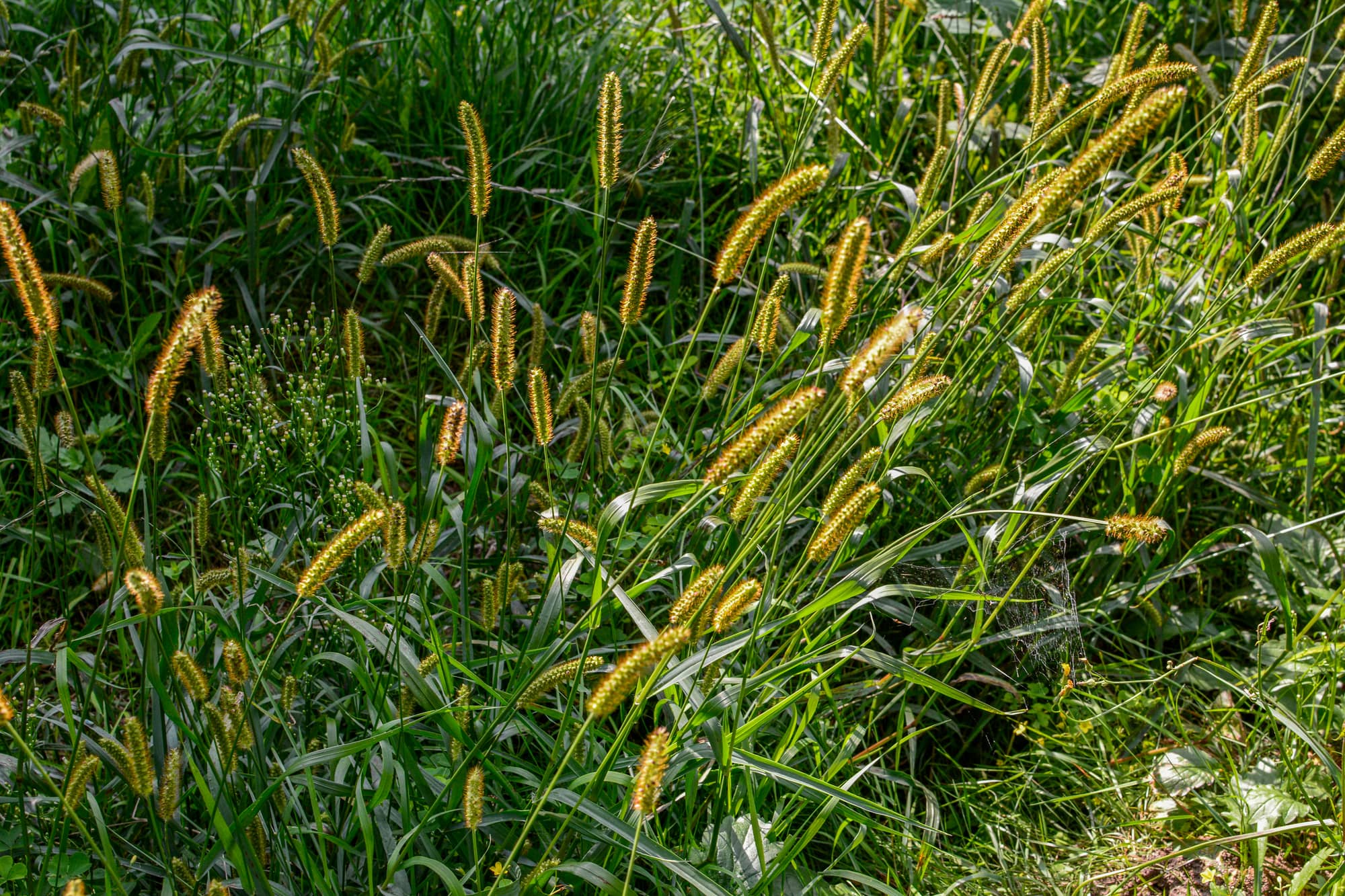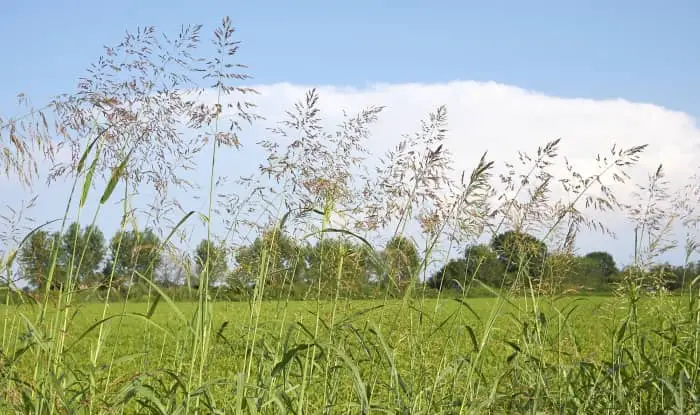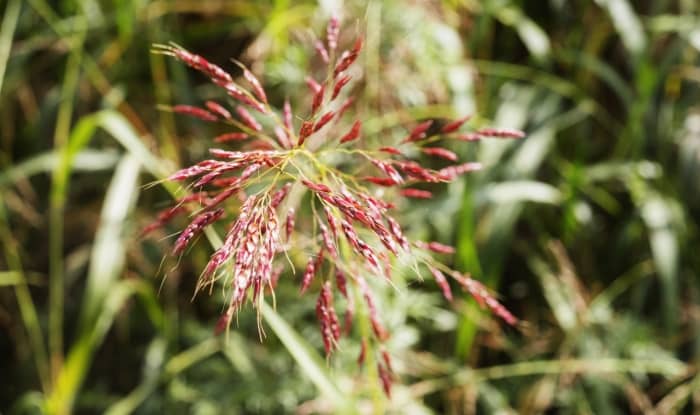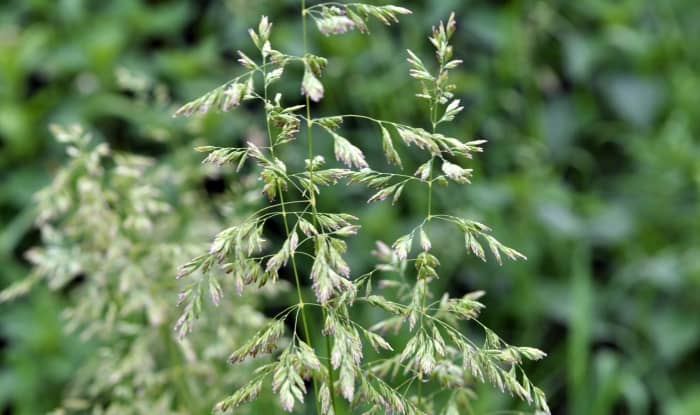Weeds that look like grass are a challenge for gardeners.
They compete with your plants for water, nutrients, and light, affecting their growth.
And because they blend into your lawn at first, it’s easy to miss the problem until they’re well established. Making it harder to get rid of them.
So to help you with early identification, I’ve prepared this list of the 10 most common grass-like weeds. And I’ll give you suggestions for how you can prevent and get rid of them.
Let’s dive in.
11 Common Weeds That Look Like Grass
Crabgrass (Digitaria spp.)

Crabgrass (also called finger grasses) looks like grass and is difficult to control
Crabgrass is an invasive weed that looks similar to grass. Only, unlike the rest of your lawn, its coarse texture, thick blades, and lateral growth cause it to stand out and look unsightly.
It’s a common annual weed that germinates, grows, and dies within the space of a year. But what it does during that year can have long-term consequences for your lawn.
Crabgrass plants produce up to 150,000 seeds. And when they die, these seeds are left behind ready to germinate in spring the following year, leading to an infestation.
Like many other types of weeds, if you leave crabgrass to grow it will crowd out and smother your lawn grass as it takes over.
And mowing won’t help you get rid of the problem, as they can set seed even when they’re only ½ inch tall. Which is lower than the recommended height for mowing lawn grass.
In order to control crabgrass, the best method is to prevent the seeds from germinating. So it’s a good idea to use a pre-emergent herbicide in early spring.
Post-emergent herbicides kill the crabgrass that’s already growing. But if they’ve already set seed, the problem will return next year.
You can also pull the plants out by hand. But depending on the size of the problem, this can be a lot of work.
Common Couch (Elymus repens)

Quackgrass by Matt Lavin from Bozeman, Montana, USA, CC BY-SA 2.0
Also known as quackgrass, this invasive weed spreads quickly across your lawn due to prolific underground rhizome growth.
But it also reproduces from seeds, which disperse through the air and germinate in thin lawns further away.
It’s easy to identify:
Firstly, it’s a tall grass that quickly develops large patches.
And secondly, the leaves are broader than most lawn grasses and feel rough when you run your fingers across them.
Having a thick and healthy lawn is a good first defense to stop it from becoming established.
If you see it growing in your garden you can try to dig it out. But it can be difficult. The roots break easily, and you have to make sure you don’t leave them behind or the plant will grow back.
You can get rid of quackgrass using herbicide. But most selective weed killers don’t work. And using a non-selective product will also damage your lawn unless you’re very careful.
Green Foxtail (Setaria viridis)

Green foxtail bristles
Also known as wild millet, green bristlegrass, and pigeongrass, green foxtail has distinctive green ‘foxtails’ of seeds that resemble bristles on the end of its grass-like stalks.
It grows tall, anywhere from 10cm to 100cm. And it’s common to see it in meadows and prairies.
Green foxtail is an invasive species. And each foxtail contains hundreds of seeds that spread easily through the air. The plant can quickly become problematic in an area.
Making sure your lawn is thick and lush to prevent green foxtail from establishing itself. Weed control is rarely necessary for healthy lawns that are well cared for.
If you find it growing on your lawn, consider using a selective herbicide that kills green foxtail while leaving your grass unharmed.
Nutsedge (Cyperus rotundus)

Yellow nutsedge weeds look similar to grass by Homer Edward Price, CC BY 2.0
Before it blooms, nutsedge resembles tall grass. But there are some distinctive differences when you look closely
To start with, nutsedges are V-shaped. And they’re usually thicker and stiffer. With leaves in a set of 3, rather than the set of 2 commonly seen on grass.
Yellow nutsedge produces golden-yellow flowers and seeds. With purple nutsedge producing red-brown flowers when they bloom, and dark brown or black seeds.
It’s a perennial weed that spreads by seed, underground rhizomes, bulbs, and tubers. With each tuber having the capacity to create hundreds of shoots in a 3-6 ft. area. As well as forming 100+ new tubers.
This makes it very hard to control. The key is to stop it from establishing itself, as once it does, it’s one of the most difficult weeds to get rid of.
Make sure you remove young plants before they’ve had a chance to develop the tubers.
If you find mature nutsedge plants already established in your garden, then pulling them out is unlikely to work. If you leave the rhizomes and tubers behind they will continue to sprout.
Instead, get a herbicide that targets nutsedge and can kill everything above and below the ground.
A more organic strategy is to grow a dense lawn that can crowd it out. Preventing it from being able to successfully root.
Nutsedge often thrives in waterlogged soil. So eliminating the wet conditions that help it to grow is a good idea.
Slender Rush (Juncus tenuis)

Slender rush growing in clumps
Also called field rush, poverty rush, and path rush, this perennial weed is usually visible in clumps.
It has grass-like leaves that grow from the lower part of its wiry, dark green stems. And grows somewhere between 15-60 cm tall.
It reproduces by seeds that are held in small, brown, egg-shaped pods at the end of the stems. And also develops rhizomes under the ground.
JAMES LINDSAY AT ECOLOGY OF COMMANSTER, CC BY-SA 2.5, VIA WIKIMEDIA COMMONS
The best method for getting rid of small populations of slender rush is pulling by hand. Just make sure you remove the roots as well.
Systemic herbicides can help you control it. But you’ll have to be careful when using them because they can kill grasses and nearby plants as well.
Smooth Bromegrass (Bromus inermis)

Smooth Bromegrass is a highly adaptable perennial weed that can grow even in the cold conditions of winter, but it can also resist heat and drought.
It particularly thrives in deep, moist, and well-drained soils. Developing a large root system, and forming sod.
The plant grows between 15-30 inches tall and produces many leaf blades that look like grass. The leaves have flat and smooth blades with rough margins. And have a distinctive W or M constriction about ⅔ rds of the way up.
It’s quite popular with farmers, who plant it deliberately because of its usefulness as hay, silage, and pasture. As well as its ability to prevent soil erosion.
But if you find it in your garden, that might not be much use to you. And it spreads rapidly through seeds and rhizomes. Quickly taking over thin lawns.
The plant recovers poorly from cutting. So keeping it mowed close to the ground can help to control it. And growing a thick lawn can crowd it out.
Post-emergent weed killers that contain glyphosate, such as Roundup, can kill the plant all the way to its roots and stop its spread.
Tall Fescue (Festuca arundinacea)

Tall fescue grass grows faster and taller than most lawn grasses, by Daderot, Public domain, via Wikimedia Commons
Tall fescue is a species of grass that’s popular with some homeowners because it’s well-suited to Northern lawns.
But, it’s also an invasive perennial weed on lawns that consist of a different turfgrass.
It stands out because it grows faster than the surrounding grass and in clumps. With a height of somewhere between 6-20 cm. The stiff, broad leaves have rough margins and edges, and are up to 1 cm in width.
Once tall fescue is established, the thick root mass is extremely difficult to pull out by hand. And leaving any of the roots behind allows the plant to regrow.
Non-selective herbicides, such as glyphosate, will kill tall fescue. But you have to be careful when spot-treating, as it will also kill any other plants you spray it on.
Wild Garlic & Wild Onion (Allium vineale & Allium canadense)

Wild onion looking similar to grass, by Michael Trolove / Wild Onion / CC BY-SA 2.0
These common lawn weeds closely resemble tall grass. But it’s easy to tell the difference when you get close to them because of the smell.
Both wild onion and wild garlic have a strong fragrance that immediately makes them stand out. And this is particularly noticeable after you’ve mowed them.
They’re also very fast-growing. So they quickly rise above the height of the grass on your lawn. And unlike most grasses, they appear in clumps.
Look out for them growing in early spring and late fall. They’re dormant in the summer.
WILD ONION FLOWERS
They’re easy to get rid of, you can dig them up with a spade. Make sure you remove the bulb from the ground or they’ll grow back again.
You can also use 3-way broadleaf herbicides that contain 2,4-D, mecoprop, and dicamba.
These are safe to use on most lawn grasses. But always check the instructions to make sure it’s okay for your turfgrass. In particular, some types of St. Augustine grass, and bermuda grass can be harmed.
Johnsongrass (Sorghum halepense)
Sorghum halepense, commonly known as Johnsongrass, is a robust plant that can grow to impressive heights, reaching up to 7 feet tall, making it a substantial presence in the landscape.
The leaves of Johnsongrass have flat blades and range from hairless to sparsely hairy. They grow large, contributing to the plant’s overall stature. One distinctive attribute is the prominent white midvein that runs through the leaves.
From May to October, Johnsongrass produces dark reddish flowers, growing in large, well-branched flower heads, adding a splash of vibrant color to your garden.
Johnsongrass has an extensive root system, including thick, cream-colored rhizomes. The rhizomes send up stalks that form dense stands. The plant’s prolific growth and efficient spreading mechanisms allow it to colonize new areas rapidly.
Native to Asia and North Africa, Johnsongrass now grows on all continents as an introduced species. It is particularly invasive in areas with disturbed ground, including cultivated fields, roadsides, and other disturbed habitats.
Managing and controlling Johnsongrass can be challenging due to its resilient nature. Strategies for control include regular mowing or cutting to prevent seed production, hand removal for small infestations, and selective herbicides designed to target grassy weeds. Integrated Weed Management practices, combining various control methods, may be necessary for effective long-term control.
Johnsongrass is a noxious weed in many US states, highlighting its detrimental impact on agriculture and native ecosystems. It competes with desirable plants, affecting crop yields and biodiversity. The plant’s ability to thrive on disturbed ground and rapidly colonize cultivated fields makes it particularly troublesome, with cotton fields in California being a notable example of its invasive tendencies.
Annual Bluegrass (Poa annua)
Poa annua, commonly known as annual bluegrass, is a small but resilient plant that typically grows between 3 to 12 inches, giving it a low, compact appearance. The plant stems are slender and upright, arising from a basal rosette of leaves.
The leaves of Poa annua are narrow and elongated, with a smooth texture. They are typically bright green and form dense tufts or clumps. Although the weed is related to Kentucky bluegrass (Poa pratensis), it is a lighter and brighter shade of green.
Annual bluegrass produces small, delicate flowers arranged in compact, open clusters called panicles. Each flower consists of tiny, inconspicuous spikelets.
The flowers of Poa annua vary in color, ranging from pale green to light purple or even white. They are often inconspicuous, blending in with the appearance of the plant.
The root system is fibrous and shallow, consisting of fine roots that spread horizontally near the soil surface. But, unlike some other grass species, Poa annua does not produce runners or stolons but primarily reproduces by a large volume of seeds that can germinate rapidly, allowing the plant to colonize new areas quickly.
You can find annual bluegrass in various habitats. It thrives in lawns, turfgrass, golf courses, gardens, agricultural fields, disturbed areas, and even cracks in pavement.
Managing and controlling this weed can be challenging due to its ability to produce vast quantities of seeds and adapt to different environments. Control methods include cultural practices such as maintaining proper lawn care, including regular mowing, watering, and fertilizing to encourage healthy turf that can outcompete the weed.
Additionally, you can use selective herbicides designed for targeting annual bluegrass.
Poa annua is considered both a weed and a turfgrass species. It’s known for its ability to germinate in cool and moist conditions, leading to its prevalence in lawns during the winter. Its adaptability and high seed production has made it a common problem in turfgrass management.
The small size of annual bluegrass allows it to produce an impressive number of seeds in a limited area, contributing to its successful spread and persistence.
Goosegrass (Eleusine indica)
Goosegrass is a resilient and invasive weed with distinct characteristics. It typically forms low-growing clumps or mats as it grows, reaching a height of 4 to 24 inches, depending on the growing conditions.
The leaves of goosegrass are narrow and pale. They grow in a basal rosette pattern and are smooth or sparsely hairy. The leaf sheaths are often densely hairy.
Goosegrass stems are prostrate and spreading, growing along the ground rather than upright and sometimes branching.
Goosegrass produces small, inconspicuous flowers arranged in spike-like clusters called spikelets. The flowers grow on erect stalks above the foliage, are typically greenish-white to pale yellow, and lack showy petals.
The root system of goosegrass is fibrous and shallow, with fine roots that spread horizontally near the soil surface, forming a dense mat. It does not produce runners or stolons. Instead, the spread is primarily through barbed seeds that attach to animals, clothing, or machinery, facilitating their dispersal to new areas.
Goosegrass is a warm-season weed that thrives in areas with full sun or partial shade. You’ll often find it in turfgrass, lawns, gardens, agricultural fields, disturbed areas, and waste spaces. It has a wide distribution and is native to tropical and subtropical regions but has become naturalized in many other parts of the world.
Managing and controlling goosegrass can be challenging due to its prolific seed production and resilience. Control methods include regular mowing to prevent seed formation, hand removal of individual plants, and the use of selective herbicides. Cultural practices such as maintaining a healthy and dense turf can help suppress its growth and prevent establishment.
Goosegrass has earned its name due to its preference for damp areas where geese commonly graze. Its seeds are known for their ability to stick to the feathers of geese and other animals, aiding in long-distance dispersal. This plant can quickly invade turfgrass areas and agricultural fields, competing with desirable plants for resources. Its resilience and ability to adapt to various conditions make it persistent and problematic.
Eliminating The Problem
The best way to prevent weeds that resemble grasses from becoming a problem is to deal with them early before they become established and spread.
You can often manage to control them without the use of chemical herbicides. But it’s very important to remove them before they seed.
Some weeds produce thousands of seeds per plant. If you allow these to disperse around your garden, it won’t matter if you kill all the weeds you find this year. Why?
Because they can lie dormant in the soil until the next growing season and the problem will return with a vengeance.
So here are the best lawn care tips to keep unwanted plants away:
Don’t wait to remove unwanted plants. Keep an eye on what’s growing in your garden each day and take care of the job while the grassy weeds are still young. It’s usually easier to dig or pull weeds from the ground when the soil is moist after the rain rather than when it’s dry.
Make sure to clean your tools when moving from one part of your garden to another. This stops weed seeds from being transferred around your garden. It also stops the spread of harmful fungi and bacteria.
Mowing your lawn regularly can stop unwanted plants from developing to the point where they produce seeds.
When buying mulch, compost, manure, soil, etc, from garden centers, make sure it’s weed-free.
Apply a layer of mulch around plants in your vegetable garden to keep weeds out. You can also do the same with your flower beds. It can prevent seeds from landing on the soil and germinating. It’s also effective at blocking sunlight for those already in the soil.
Directly water your plants rather than covering your whole garden. This helps to limit the amount of water that weeds receive.
When cultivating your lawn, make sure you don’t over-fertilize because it will increase weed growth. But also, don’t under-fertilize and end up with a thin lawn that’s susceptible to weed invasion.
Add grass seed to areas of patchy lawn to help it grow thick, making it harder for weeds to become established.
Using a good weed trimmer can make it a lot easier to cut down weeds in difficult-to-reach places in garden beds, and tight spots.
Perennial weeds require extra care. When digging them out of the ground, the best advice is to make sure you get all of the taproot to stop them from regrowing. Be careful that pieces don’t break off when pulling them out.















For the life of me, I can’t identify what type of grass is in my yard, as it was there way before I bought my house. It’s small blades, and fast growing, but when not mowed, it has tiny black seeds that form on top. I thought it was fine fescue but it’s not. It looks good except for a few spots where it had high traffic. It has patches of whatever kind of grass was available. Sooner or later, I’ll figure it out